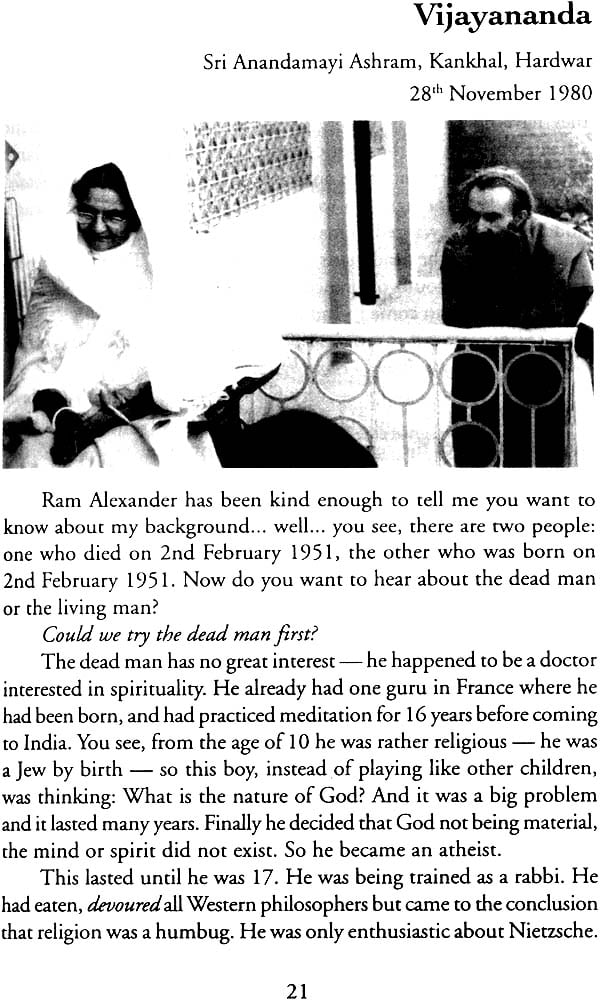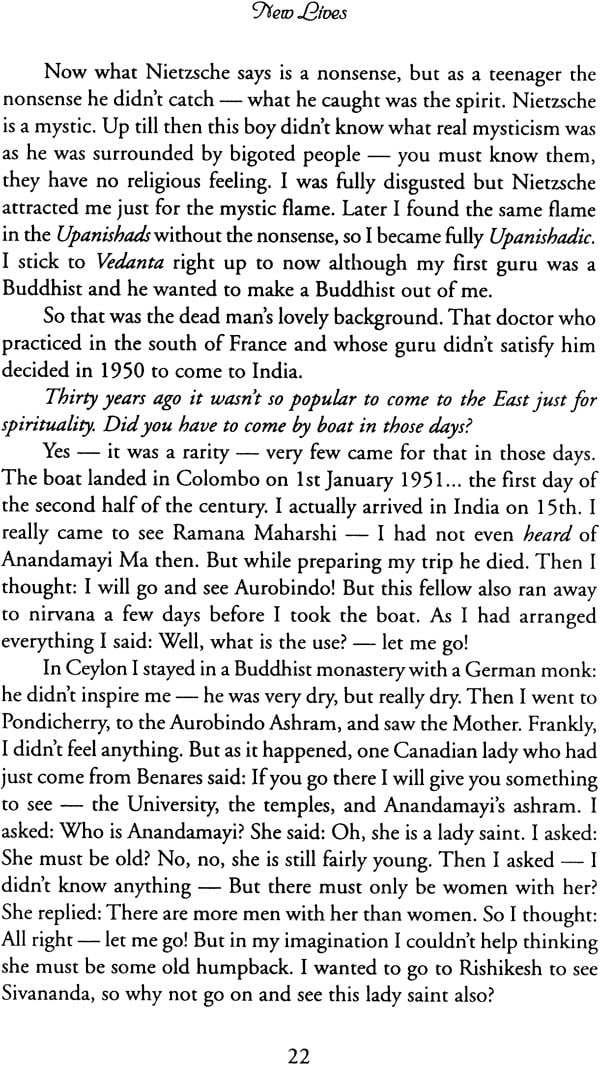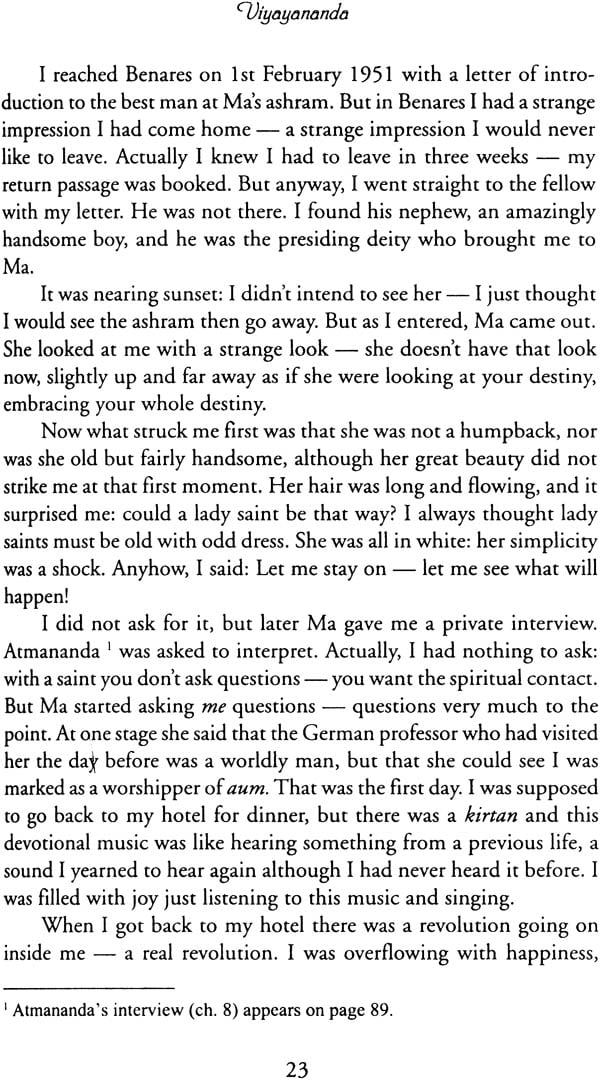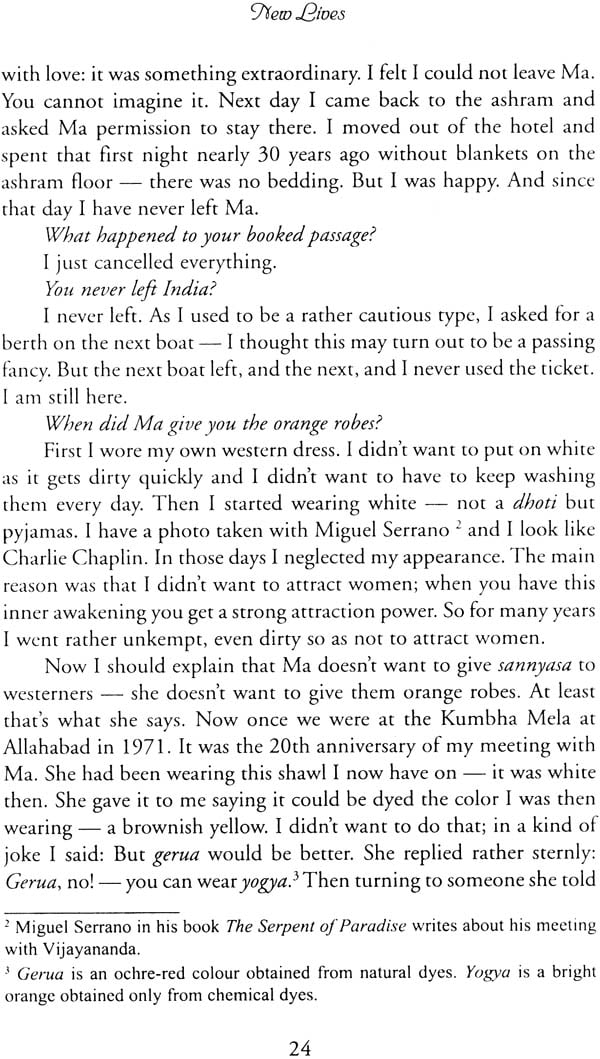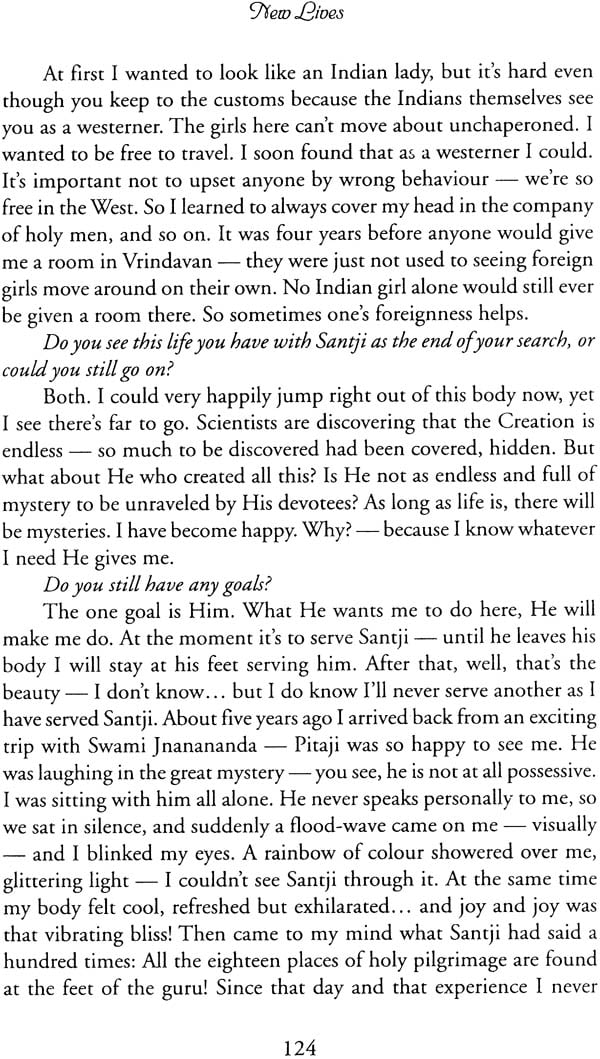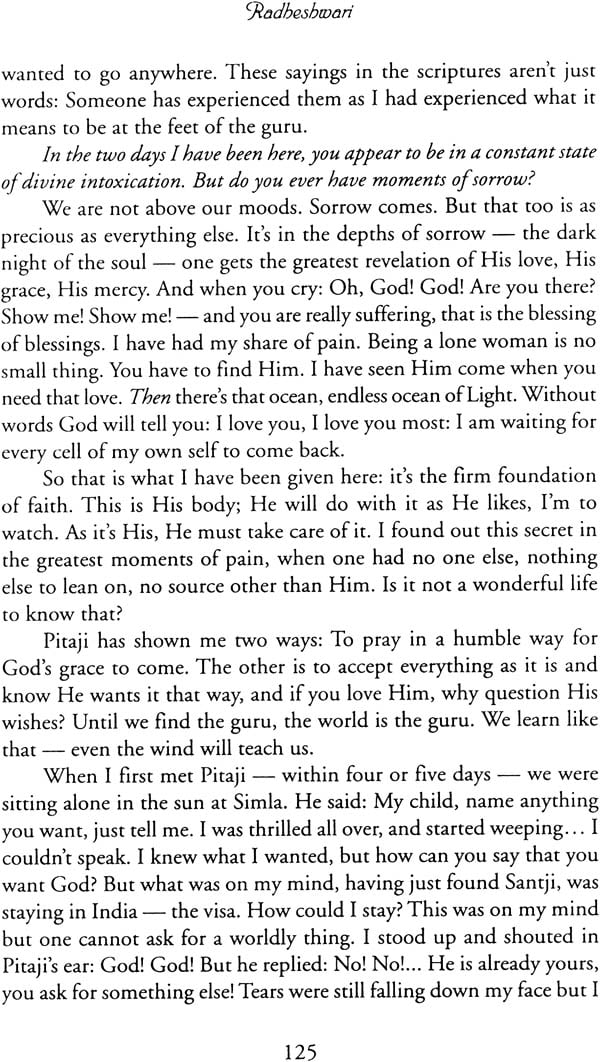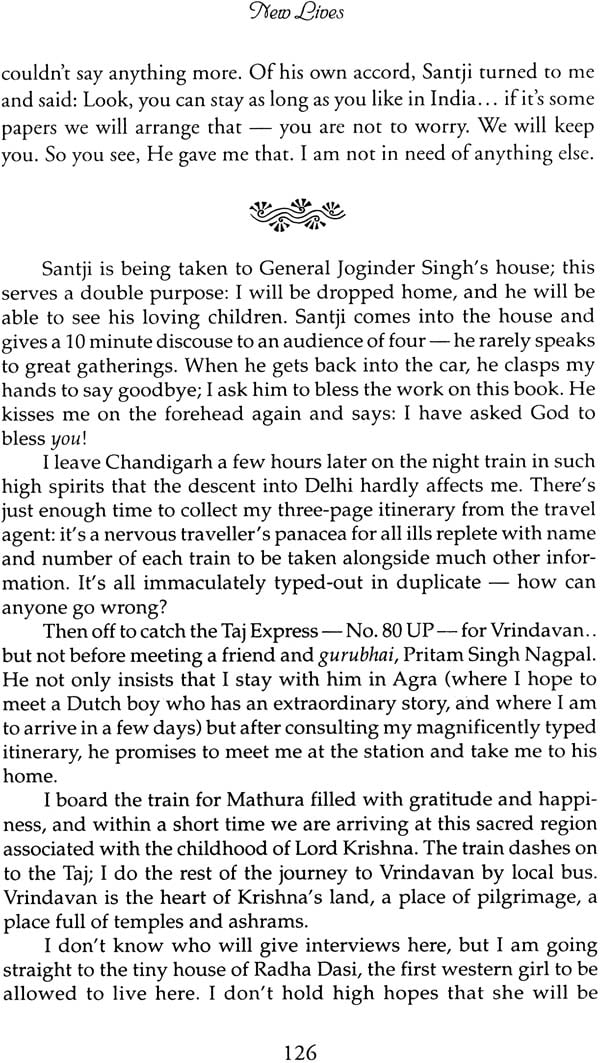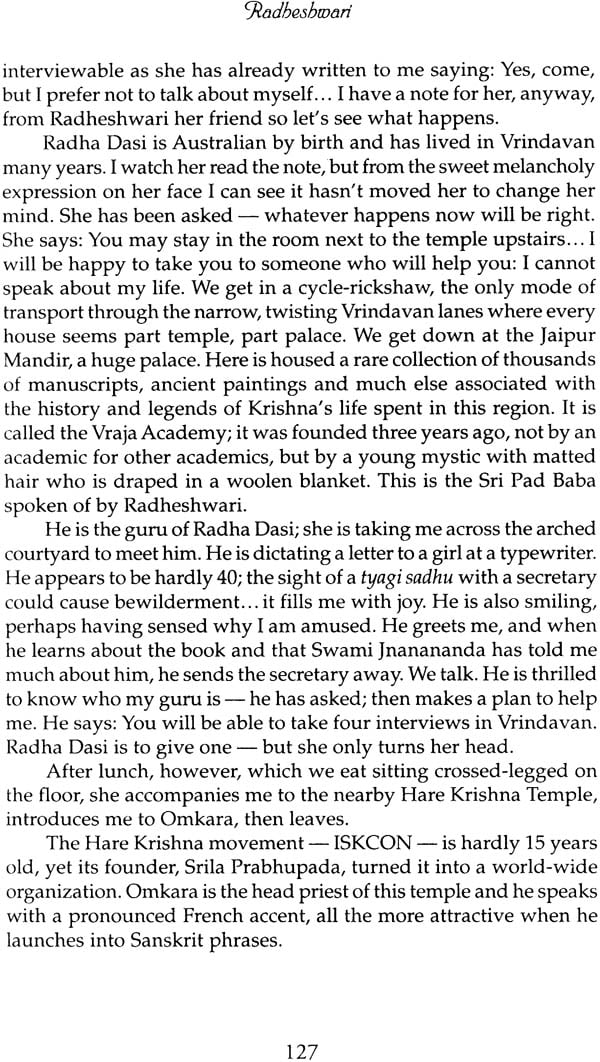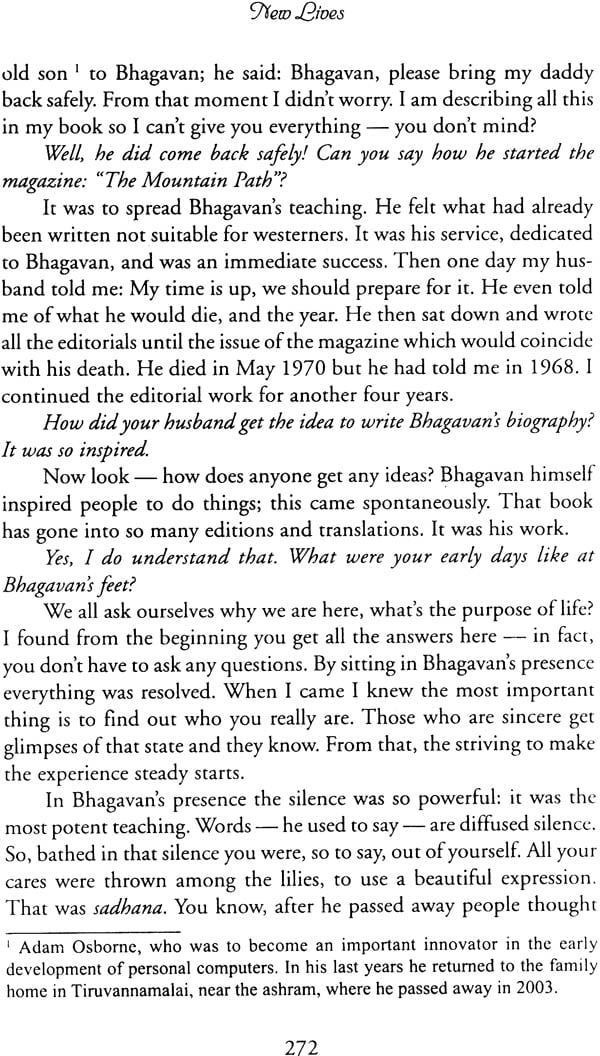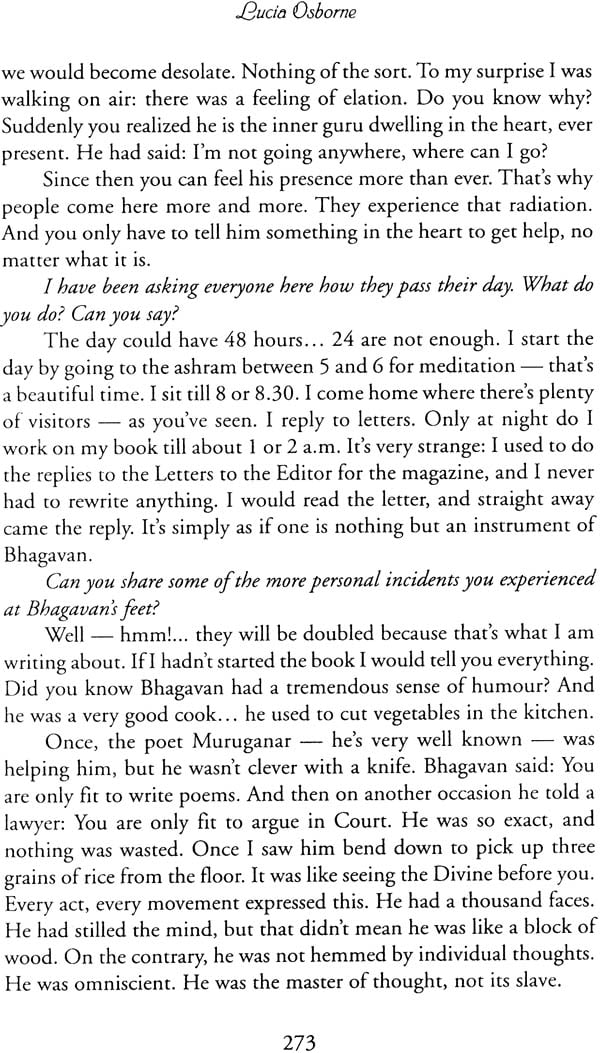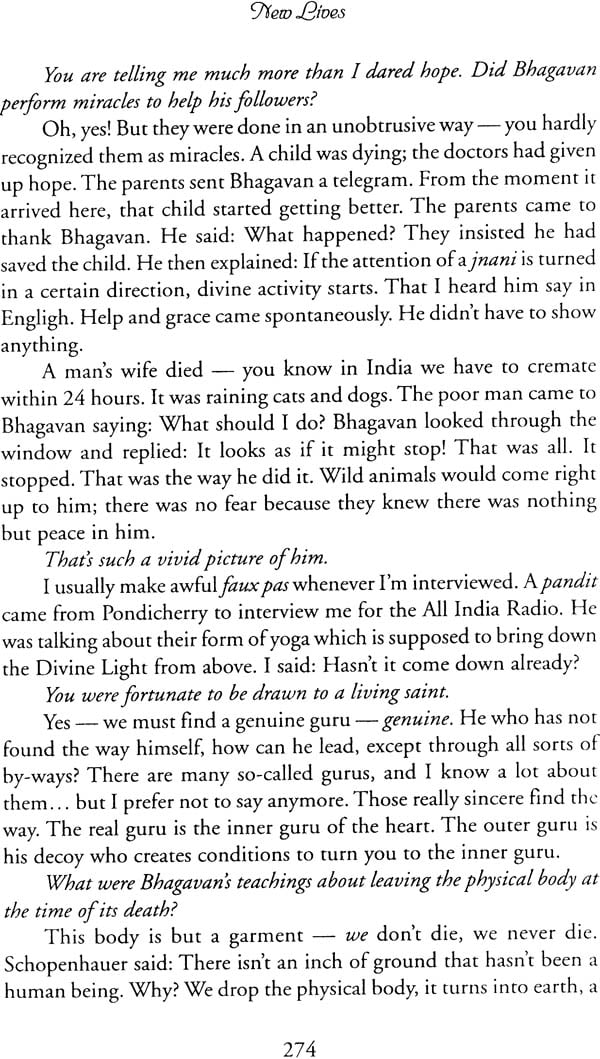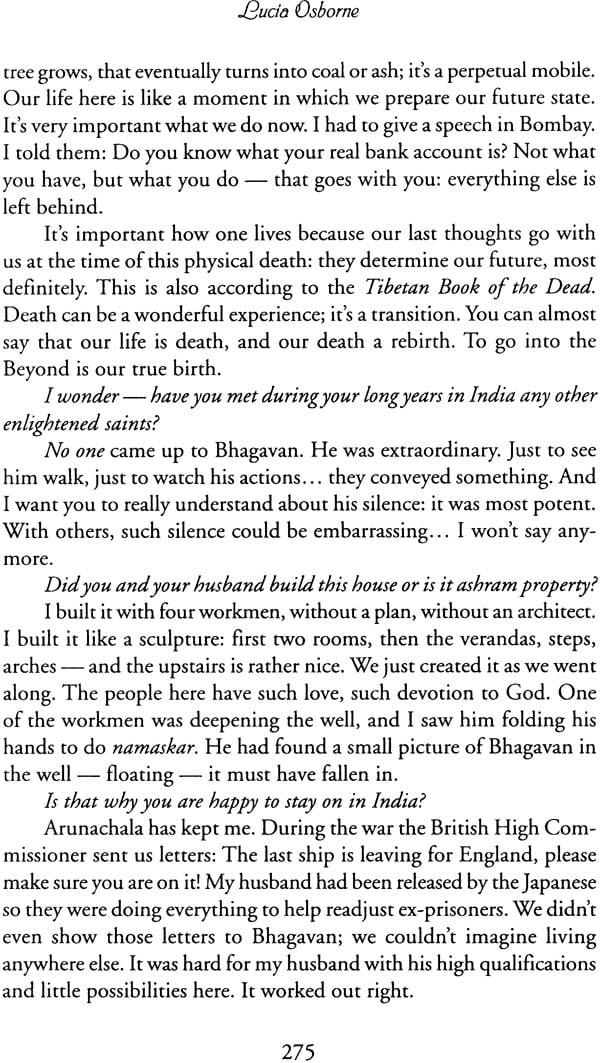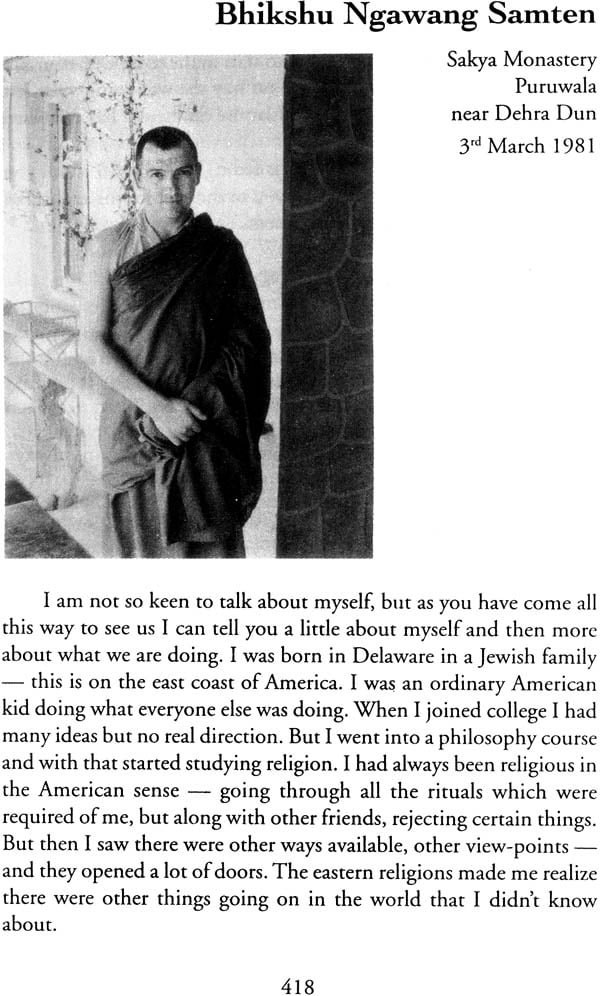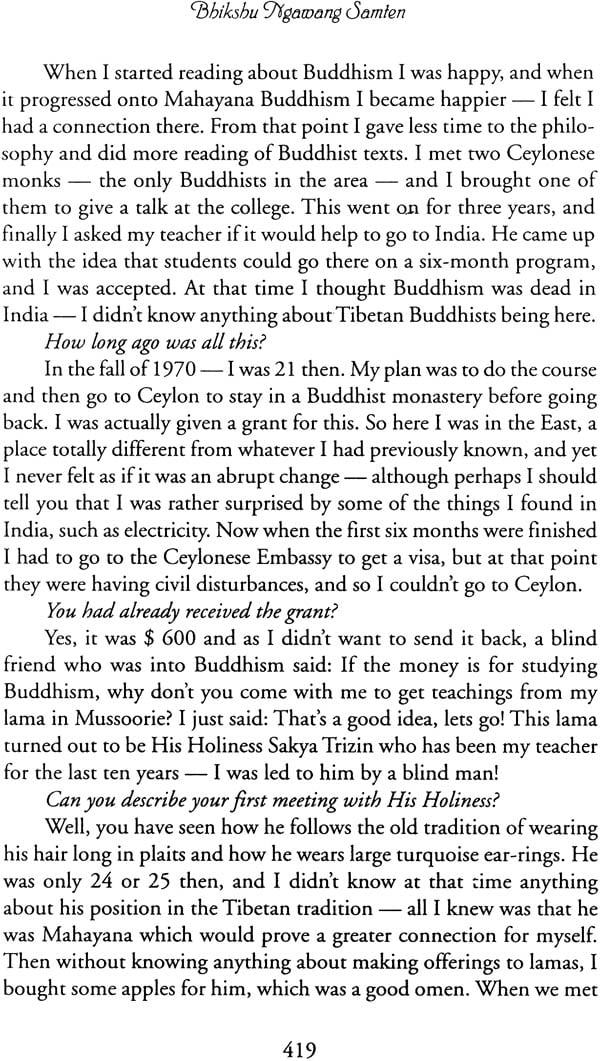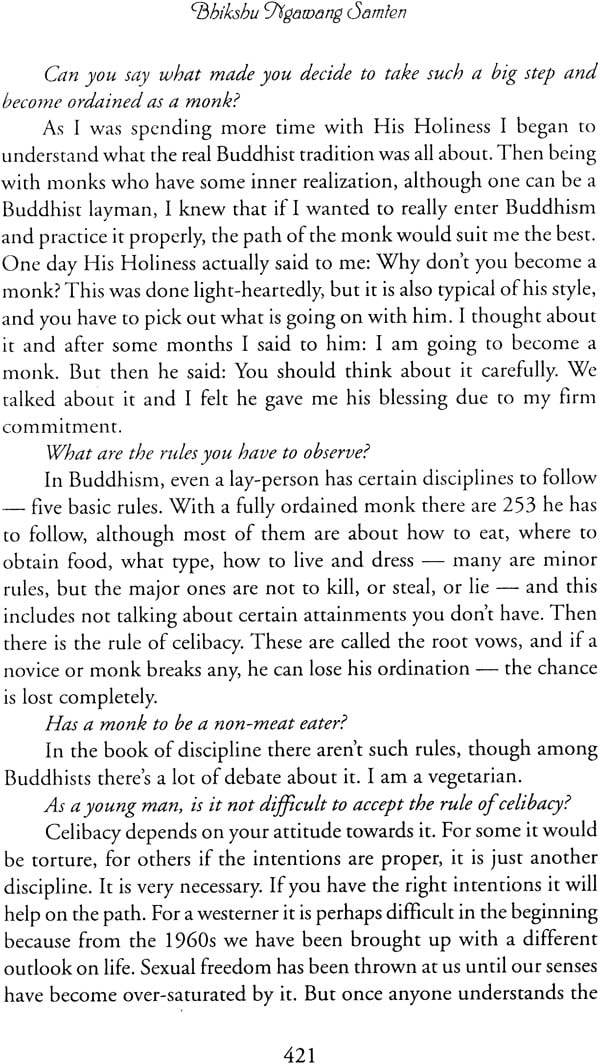
New Lives: 50 Westerners Search for Themselves in Sacred India
Book Specification
| Item Code: | IDE390 |
| Author: | Malcolm Tillis |
| Publisher: | Indica Books, Varanasi |
| Language: | English |
| Edition: | 2004 |
| ISBN: | 8186569499 |
| Pages: | 454 (B & W Illus: 48) |
| Cover: | Paperback |
| Other Details | 8.5" X 5.5" |
| Weight | 560 gm |
Book Description
Preface
During the eleven years I lived in India I was often lent or sent books about Westerns who had also come to India. But they were invariably about those Westerners who had been drawn onto the guru-trail that occasionally leads innocent victims into the hungry jaws of a white-bearded, impressively robed monster who leaves them more spiritually and materially bankrupt than before. These books were or misinformed. They made me wonder why no in-depth study had appeared dealing with the many Westerners who have taken the plunge, left the bright lights of home and are now living fulfilled lives in this vast, fascinating country. There is no shortage of books on India's host of saints, seers and gurus, but what about their Western disciples? Why has so little appeared by them, or about their achievements? They may have taken to the simple life, but surely they are not all under vows of silence.
I felt so strongly about this that I took courage, went out into the field, and collected their experiences myself. This book is the result. It is the outcome of a concentrated five-month journey that took me all over India. Sometimes I traveled under dreadful conditions for days on end in the hope of tracking down someone I had heard about. I traveled alone, reluctantly at first, until after many setbacks I was given much needed strength and reassurance by being thrown headlong into the center of a miracle, which is described in the narrative. The result of this experience along will stay with me for the rest of my life.
My intention from the start was simple enough: to tape record the personal stories of as many followers of different paths, disciplines or gurus as possible. This seemed to me the most accurate way to capture their histories, the reasons why they changed their lives and most important-what they considered the benefits from having turned East for the new life.
Above all, my intention was to publish their accounts in their own words without superimposing my own views and values. It was note specially important to me how long each person had been in India, although I caught up with some who had arrived over fifty years ago. (Russell Balfour-Clarke's ticket was paid for in 1909 by Mrs. Annie Besant, the President of the Theosophical Society, and thus he was given the remarkable task of teaching English to the thirteen-year old J. Krishnamurti.).
This commitment to the new life does not exclude dedicated followers of the Judeo-Christian tradition: Anil Bhai, born John Davis into an English Catholic family, and still very much a Catholic, is but one example. It was each person's total commitment to a chosen path, and above all why it was being pursued in India, which was the deciding factor for inclusion in the project.
For those attached to a guru or lama whether by vows or initiation, I soon noticed that the truly dedicated disciple reflects at least some of his mentor's consciousness. And that consciousness finds expression through the disciple's life-style, through his manner of speech and actions. It was because of this close, personal attachment that several portraits of a particularly intimate nature, rarely seen in print, were captured describing the unique qualities of some of India's most celebrated saints: the Frengh-born Vijayananda on Anandamayi Ma, Maggi Lidchi on the Aurobindo Mother, the Polish-born Lucia Osborne on Ramana Maharshi.
The printed word often veils the expressiveness and subtle shades of meaning conveyed by the spoken word. In the editing of these interviews in have done my best to retain each person's individual speech rhythms and idiosyncrasies. As English was not always the mother tongue of the person interviewed, this proved yet another challenge. It is, however, a cause of sadness to me that I have been unable to indicate in print the shining quality and vocal expressiveness which were often complimented by radiant facial expressions when the other-worldly beauty of the new life was being described.
Anyone who can reveal to another person his potential for experiencing the Divine within himself is surely to be revered. Most devotees, nevertheless, are inclined to revere their own guru to the exclusion of all others. This often leads to suspicion and to what I call guru-protectiveness, and this sometime made communication and enquiry from an outsider difficult. It was particularly difficult at the ashrams of Swami Muktananda and Satya Sai Baba; with Muktananda, after twenty-four hours of pleading, placating, I left without even unpacking my tape-recorder (they had actually agreed to the interviews by letter); with Sai Baba I persisted, accepted all sorts of conditions, and came away not only with a double interview but an experience I am not likely to forget.
However, most of those I met were far more approachable and cooperative although in some cases not easy to tie down. I one ashram I was kept waiting five days before the person I wished to interview could give me an hour of her time; but the interview is unique as it vividly illustrates the whole meaning of selfless service, and what it is like to be close to a guru and serve him under conditions of great trust.
I was constantly aware of the contrasts created by the abandonment of the old life for the new. What was the former principle clarinet of the Rotterdam Symphony Orchestra doing wearing flowing red robes? Or the Italian priest editing a Sanskrit magazine? Or the Californian dentist's assistant looking after the hundred-and-four-year-old Sant Gulab Singh? I found the dynamic Simonetta, once Italy's foremost woman fashion designer, happy to sleep on the floor of her ashram room. Tensin Palmo, a librarian from London, preferred living in a cave 12,000 feet above sea level. The Steiners from Australia had settled for a bungalow in the foothills of the Himalayas.
All these dramatic contrasts have leading to fulfillment, so are there just as there are so many paths leading to fulfillment, so are there travelers on the way. The routes adopted by the people I interviewed are particularly rich: starting off from seventeen different countries in the West they embraced various sects within Hinduism, Buddhism, and Christianity, as well as the Radhasoami Faith, Sikhism, and a synthesis of Hinduism and Christianity as expounded by Father Bede Griffiths.
I encouraged all those who agreed to speak to be frank about the difficulties, which are encountered along all paths of endeavour. Some have been remarkably frank. Some spoke only on condition that a transcript would be sent to them before publication. Only in one case did the person interviewed with to conceal the name of his guru. Four have become gurus themselves, a remarkable attainment in a country not lacking in home talent.
Too many others have been instrumental in encouraging and supporting me to be individually named: they know they have my gratitude.
They many remarkable people I met while working on this project have been a constant source of wonder and inspiration. Some of them have since become close friends. They may have come from diverse backgrounds, they may now be treading diverse paths, yet I see one unifying truth: once people pass through the gate into higher consciousness, no matter what manner of life-style they adopt, no matter where they choose to live, no matter if they eventually return to the West, they can never truly pass back through the gate into the old life.
Many of those interviewed have adopted Sanskrit or Tibetan names, and a few have become Indian nationals. By turning East, however, all of them are out of Western context climatically, culturally, psychological. So the question remains: in order to live the new life was it absolutely necessary to make such a dramatic change? Let them speak for themselves.
About the Book:
In the pages of this book we are taken on a profound pilgrimage of spiritual discovery. With our guide, Malcolm Tillis, we wander the length and breadth of India in search of other Westerners who, like him, have forsaken their old lives in the West for totally new, dramatically more meaningful ones in the East. By seeing Indian spirituality through the eyes of outsiders who were not born into the ancient culture, but found tremendous personal meaning therein, we discover it new and fresh with each individual Malcolm interviews. Each of these individuals has discovered an enormous spiritual wealth in India that makes the material prosperity and technological 'advancements' of the West seem obscenely desolate and primitive in comparison. Contemporary Indian readers should find this particularly relevant, as India becomes more 'modern' and on par with the West, and as they find themselves increasingly in a similar position with regard to rediscovering their own heritage.
Some of the people interviewed, renowned today, have remarkable life-stories:
Vijayananda met the great saint Anandamayi Ma with whom he found all he had hoped for. He moved into her ashram to live the life of a contemplative reununciate, where he remains to this day, now a revered and venerable teacher himself.
Ani Tenzin Palmo (Diana Perry) spent much of her time residing and meditating in a cave in the Himalayas at an altitude of over 12,000 ft. Today she is one of the better known figure in contemporary Buddhism.
The Swiss Swami Jnanananda took the formal vows and garb of a Hindu monk and then spent years wandering and meditating in the Himalayas in the company of saints and yogis. Today he is a beloved teacher residing in the foothills of the Himalayas.
Bill Aitken is a noted author of books about his adopted homeland.
Atmananda, an Austrian classical pianist, translated and edited the primary works about her Guru Anandamayi Ma into English, and ultimately became a Hindu sannyasini
Lucia Osborne, wife of the writer Arthur Osborne, was a close follower of the great sage Ramana Maharshi.
Father Bede Griffith, the Benedictine monk and well-known author, spent his life formulating a synthesis of Christianity and Hinduism.
| Introduction: The Final Interview | 7 | |
| Preface | 16 | |
| 1. | Vijayananda | 21 |
| 2. | Melita Maschman | 31 |
| 3. | Brahmachari Gadadhar | 40 |
| 4. | Bill Eilers | 47 |
| 5. | Simonetta | 56 |
| 6. | Swami Jnananda | 66 |
| 7. | Bill Aitken | 78 |
| 8. | Brahmacharini Atmananda | 89 |
| 9. | Jamie Smith | 99 |
| 10. | Martha Smith | 108 |
| 11. | Radheshwari | 114 |
| 12. | Omkara Das Adhikary | 128 |
| 13. | Gopi Jai Krishna | 136 |
| 14. | Ellen Schector | 144 |
| 15. | Paul Ivan Hogguer | 153 |
| 16. | Giorgio Bonazzoli | 165 |
| 17. | Anil Bhai | 172 |
| 18. | Russell Balfour-Clarke | 178 |
| 19. | Peter Hoffman | 186 |
| 20. | Dhruva | 194 |
| 21. | Maggi Lidchi | 203 |
| 22. | Baruni | 211 |
| 23. | Michael Zelnick | 218 |
| 24. | David and Sally | 224 |
| 25. | Wilhelmina van Vliet | 231 |
| 26. | Norman C. Dowsett | 236 |
| 27. | Father Bede Griffiths | 245 |
| 28. | Matthew and Joan Greenblatt | 254 |
| 29. | Lucy Cornelssen | 260 |
| 30. | Doris Williamson | 265 |
| 31. | Lucia Osborne | 270 |
| 32. | David Godman | 277 |
| 33. | Hamsa Johannus de Reade | 283 |
| 34. | Sir | 295 |
| 35. | Joachim Peters and Uli Steckenreuter | 306 |
| 36. | Richard Willis | 315 |
| 37. | Chitrakara Das Adhikary | 326 |
| 38. | Aviva Keller | 335 |
| 39. | Ma Prem Leela | 345 |
| 40. | Swami Prem Pramod | 355 |
| 41. | Swami Anand Bodhisattva | 367 |
| 42. | Swami Nadamo | 373 |
| 43. | Sister Arati | 378 |
| 44. | Francis Reck | 386 |
| 45. | H.H. Giriraja Swami | 393 |
| 46. | Jean Dunn | 402 |
| 47. | Raymond and Maree Steiner | 410 |
| 48. | Bhikshu Ngwang Samten | 418 |
| 49. | Tenzin Palmo | 428 |
| 50. | Kate Christie | 440 |
| Glossary | 449 |
